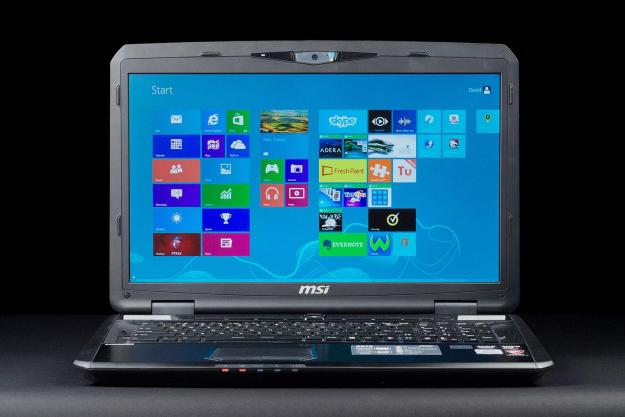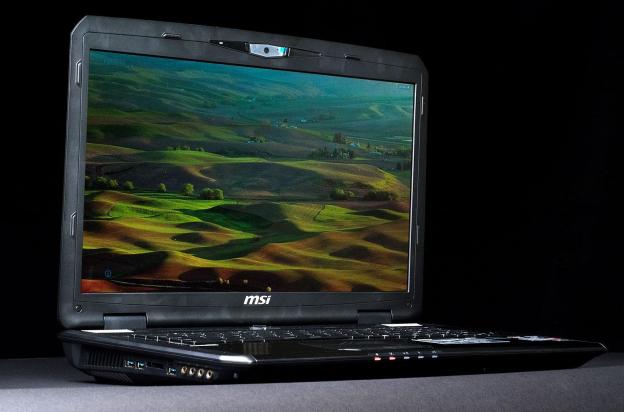
“Though it certainly looks the part, the GX70’s performance won’t satisfy hardcore gamers.”
- Loads of connectivity
- Excellent keyboard with colorful backlighting
- Quality matte display
- Great speakers
- So-so build quality
- Tiny touchpad
- Below-average performance
- Short battery life
- Poor value
AMD’s perpetual uphill battle has, in recent years, turned into a straight vertical climb. Though still producing new chips, the company’s desktop and laptop processors have been continually thrashed in both reviews and on the market. To say the fight isn’t fair would be an understatement.
That hasn’t kept AMD from trying, however, and the company does have a clear vision for its future. By promoting a balance of processor and graphics performance, along with new low-power, low-cost processors, it hopes to build system that offer a more complete experience than Intel. This is as relevant to gaming as it is mobility, because games tend to tax both the CPU and GPU; if one falls behind, overall performance may not meet expectations.
Enter the MSI GX70. This gaming laptop packs a quad-core AMD A10-5750M processor and a Radeon 8970M, the company’s second most popular mobile graphics solution, yet sells for just $1,300 (and can be had for a tad less if you hunt for a deal). That’s $100 less than an Asus G750, a laptop we think to be among the best values in gaming. At first glance, then, it seems the GX70 is well positioned. But is the hardware really fast enough for hardcore gamers?
Big and brash
The gaming laptop market, like the recent of the laptop market, has taken a turn toward thinner, lighter systems, but MSI didn’t get that memo. The massive GX70, with its 17.3-inch display and 2-inch thick chassis, looks much like any gaming system sold three years ago. Black dominates the exterior and interior (a few LED-backlit highlights excluded) and even the front lip sits over a half-inch above whatever surface the laptop is placed on.
Unfortunately, the old-school look also means old-school build quality. Panel gaps are tight enough, but easy to find, and flex can be found almost anywhere a user might care to touch. The keyboard is particularly floppy, and makes a poor impression compared to systems like the Asus G750 or Alienware M17X. Other design queues, like the touch-sensitive system-function buttons above the keyboard, are functionally fine but feel low-class.
While design isn’t the GX70’s forte, connectivity most certainly is. The system offers three USB 3.0 ports, two USB 2.0 ports, VGA, HDMI, DisplayPort, 5.1 audio, and Ethernet via a Killer Gaming network adapter. A Blu-ray drive is also part of the deal.
The incredible rainbow keyboard
Many laptops have branded speakers, but the GX70 has something different; a branded keyboard. Designed by gaming peripheral company SteelSeries, the keys are laid out conventionally and back-lit by a literal rainbow of colorful LEDs which can be customized using bundled software. Color, brightness and pulse can be adjusted; there’s even a “gaming mode” which only lights the area surrounding WASD, the four keys commonly used for control in first-person shooters.
The GX70’s keyboard is among the best in its class.
Key feel is great, and the layout manages to be spacious despite the inclusion of a full-sized number pad. There’s plenty of room along the palmrest, too, which makes for relaxing, enjoyable typing. We do wish the key-caps were better defined, as their flat tops make touch typing a hair more difficult than it should be, but this is nit-picking. Overall, the GX70’s keyboard is among the best in its class.
We can’t heap the same praise on the touchpad, however. Though it does include two discrete, tactile buttons, they don’t provide much travel. Worse, the touch surface is so small it would seem more at home on a 12-inch ultraportable than a 17.3-inch behemoth. Most buyers will want to plug in an external mouse even when the laptop isn’t used for gaming.
Matte can be beautiful, too
Most

Subjectively, it all adds up to a great experience. The high contrast ratio provides a sense of depth in video content and games, yet the matte coating makes for excellent everyday use. Most competitors provide a similar experience, but they do so with glossy screens prone to intense reflections.
Audio quality is another high point. The GX70’s combination of two forward-facing speakers and a built-in subwoofer makes for a well-rounded experience that’s great even by the high standards of a gaming laptop. Distortion is minimal, maximum volume is high, and bass is easily reproduced. A pair of external speakers can be an improvement, but you’ll have to spend over $100 to buy a 2.1 system that’s clearly superior.
The processor that couldn’t
Our review unit, like all GX70s for sale in North America, came with an AMD A10-5750M processor. This is the most powerful mobile processor AMD currently produces, so we expected top-tier performance. Instead, SiSoft Sandra’s Processor Arithmetic benchmark came to a below-average result of 30.57, a lower score than most Intel dual-cores. 7-Zip produced a more respectable result of 9,117, but this is still only half the performance of a modern Intel Core quad.
PCMark 8’s Creative benchmark, an intensive multi-component test, came to a more favorable final score of 3,450. This is the best of the systems we’ve reviewed using PCMark 8 so far, which lends some credence to AMD’s claim that a balanced approach can sometimes make up for below-average processor performance. The PCMark 8 storage test also came to respectable score of 4,033, which is slightly below average, but far from poor.
The GX70 fails to prove AMD processors can handle hardcore mobile gaming.
Of course, this is gaming laptop, so 3D performance is paramount. The Radeon 8970M looks set to compete with Nvidia’s best on paper, but in 3DMark it came to a Cloud Gate score of 4,434 and a Fire Strike score of 904. These results are far behind the competition; even the Acer Aspire V7, which we tested with a mid-range Nvidia GT 750M, scored better.
To see how these scores translate to real-world gaming we fired up The Elder Scrolls V: Skyrim, which ran at 54 frames per second with detail set to High. Though an adequate score, competitors like the Asus G750 can run the game on Ultra High at its 60 FPS software cap.
We also put the GX70 to the test with Rome II: Total War, a new and extremely demanding strategy game. At Ultra detail the framerate was an unacceptable 14 FPS on the campaign map, and turning detail down to the Low present only bumped that number up to 26 FPS. This is a very poor result that indicates this laptop may not be able to handle new, graphically demanding games.
Bulky and heavy
The GX70’s weight of just over 8.5 pounds instantly kills any hope of acceptable portability. Gamers will need a very large backpack to even fit this laptop, and once stowed, its burden will be noticeable. LAN warriors may find it acceptable, but the average user won’t want to lug this one around.
That’s probably for the best, as battery life isn’t up to par. We recorded five hours and three minutes of endurance during our light-load reading test and just 3 hours and 52 minutes during our Peacekeeper browser benchmark. These numbers are not terrible for a gaming system, but they don’t compare well to competitors with fourth-gen Intel Core processors, many of which offer 5-6 hours of Web browsing.
Our wattmeter showed the GX70 consuming 24 watts at idle with the display set to 100 percent, a moderate amount of a laptop in this category. A full load, however, drastically increased consumption to 150 watts. We were surprised by this figure, as it’s higher than many other
Effective, but loud, cooling
This laptop’s high load power draw led us to expect high operating temperatures, so we were surprised to find the system idling around 84 degrees Fahrenheit and hovering just under 100 degrees at full load. The highest external temperatures were restricted to a limited area on the bottom of the laptop, as well; the keyboard always remained pleasantly cool.

Much of the credit no doubt can be given to the system fan, which is aggressive and always audible. We picked up 41.4 decibels of noise at idle, a figure that went as high as 49.4dB at maximum load. 50dB is about as loud as a regular conversation. This is hardly an outrageous figure for a gaming system, but recent competitors have proven quieter. The Asus G750 and Razer Blade are both no louder than 46dB.
Conclusion
MSI’s GX70 is a laptop with many pros and many cons. The system has a great keyboard, tons of ports, a quality non-gloss display and superb speakers. But it also suffers from spotty quality, a miniscule touchpad, and inferior endurance.
Ultimately, though, this is a gaming laptop, and that’s where the GX70 really falls flat. Though certainly capable of playing modern games, its performance figures are poor across the board and, in some cases, lag competitors by 50 percent. The processor is a particular sore point. Despite its four cores, it falls behind the most modern dual-cores from Intel … and even the generation before that. Games simply don’t run as well as they should on a $1,000+ laptop built specifically for hardcore players.
Even the value argument falls flat, as the GX70 undercuts the superior Asus G750 by only $100, and even MSI’s own GE70 (which has a much quicker Intel quad) is just $150 more. Gamers who want a matte display or a great keyboard might give this AMD-powered rig a glance, but everyone else should move on.
Highs
- Loads of connectivity
- Excellent keyboard with colorful backlighting
- Quality matte display
- Great speakers
Lows
- So-so build quality
- Tiny touchpad
- Below-average performance
- Short battery life
- Poor value
Editors' Recommendations
- 9 best processors for PC gaming: tested and reviewed
- Best HP laptop deals: Get a 17-inch workhorse for $270 and more
- MSI Claw slammed as ‘impossible to recommend’ in early review
- MSI just went hard
- Lenovo just made my favorite gaming laptop even better









